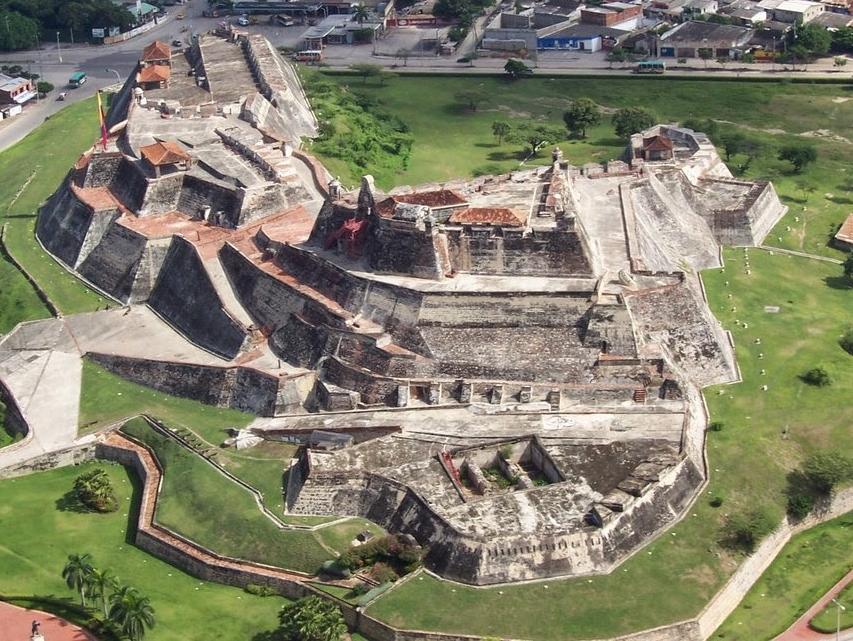
War and Social Upheaval: The War of Jenkens' Ear (1739-48)

Figure 1.-- The Castillo de San Felipe de Barajas in Cartagena, Colombia was one of several massive Spanish forts built to protect the annual Spanish treasure (primarily silver) fleets sailing to Spain. The forts help defeat English attacks during the War of Jenkens' Ear. Some 10,000 English soldiers were lost during the attack on the city (1741). Disease was a major factor, but the forts akso held. A factor here was the guns of the English ships could not be elevated sufficently to do great damage to the Spanish forts.
|
|
The rather dismissive name of the War of Jenkens' Ear obscures what was arguably the most impprtant war that all but historians know about. The Treaty of Utrecht (1713) ending the War of the Spanish Secession included provisions defining the boundaries of the European overseas empires. The treaty guaranteed the British some commecil rights in the hitherto legally closed Spanish Empire in the Americas. The British were given a 30-year exclusive contract to sell slaves to the Spanish colonies--the asiento. The English were also permitted to send one merchant ship a year to the Portobello trading fair. Portobello was located on the Caribbean coast of Panama. It was not a major port like Cartagena. It was a key port for the Spanish treasure ships. The Spanish brought silver from their phenominlly productive mines in Peru up the coast to Panama City and by mule caravana transited the Istmus where it could be loaded aboard galleons for shipment back to Spain. Despite the echaustive efforts Conquistadoes to find El Dorado, the Spamish found little gold in the America. What they found was vast deposits of silver, in both Peru (Bolivia) and Mexico. Portobello and a trading fair came to life for 2-weeks every year when the silver arrived from Peru and the galleons arrived from Spain. The galleons arrived with a variety of trade goods for sale to the people of Panama City and shipment to Peru. The English wanted into this immensly valuable trade. The colonial provisions of the Treaty of Utrecht, however, created a great deal of tension. The Spanish navy on the outlook for pirates and unauthorized English traders regularly stopped and inspected English ships. On one such incident, Spanish authorities cut off the ear of Robert Jenkens, the master of an English merchant ship (1731). Cpt. Jenkins retrieved his ear and pickeled it in a jar. English West Indian merchants who wanted more access to lucrative Spanish colonial markets lobied the British Government to prevent Spain from interfering with their attempts to trade in the Americas. Several years later, Cpt. Jenkens waved the jar with his severed ear at a session of the House of Commons. Prime Minister Robert Walpole was forced into a political corner and had to declare war (1739). The outcome of the War had few important consequences, but that was only because the English failed in campaigns to take the major Spanish bastions (St. Augustine, Havana, and Cartagena) defending tha annual treasure fleet transporting silver to Spain. The strength od the Spanisg fortificatuins as well as disease defeating the attacking Britisgh forces. The importance of silver at the time can not be overstated. It was vital fo trade with China, at the time the largest and most developed economy in the world and the major engine of international commerce. And there was a huge demand in Europe for Chinese products (silk, porcelin, tea, and other goods). Spanish power at the time had declined and the English saw the opportunity of seizing the Spanish Empire with its valuable silver mines. The British gained a victory at Portobello--which was commenorated by naming a now famous London street. The Spanish, however, held their major castions. Had the english suceeded, the history of Lar\tin America today would be very different. An interesting footnote is that a fervent British patriot in Virginia, one Lawrence Washington, named the family home, Mt. Vernon, after the British victor--Sir Edward Vernon. The outbreak of war between Britain and Spain, was followed the next year by Prussia's invasion of Austria Silesia which soon widened into a major European War--the War of the Austrian Secession. When Britain and Spain entered that continental War, the War of Jenkins Ear merged into the War of the Austrian Secession.
CIH

Navigate the Children in History Website:
[Return to Main specific 18th century war essay page]
[Return to Main military style page]
[About Us]
[Introduction]
[Biographies]
[Chronology]
[Climatology]
[Clothing]
[Disease and Health]
[Economics]
[Freedom]
[Geography]
[History]
[Human Nature]
[Ideology]
[Law]
[Nationalism]
[Presidents]
[Religion]
[Royalty]
[Science]
[Social Class]
[Bibliographies]
[Contributions]
[FAQs]
[Glossaries]
[Images]
[Links]
[Registration]
[Tools]
[Children in History Home]
Created: 11:29 AM 6/2/2019
Last updated: 11:29 AM 6/2/2019



